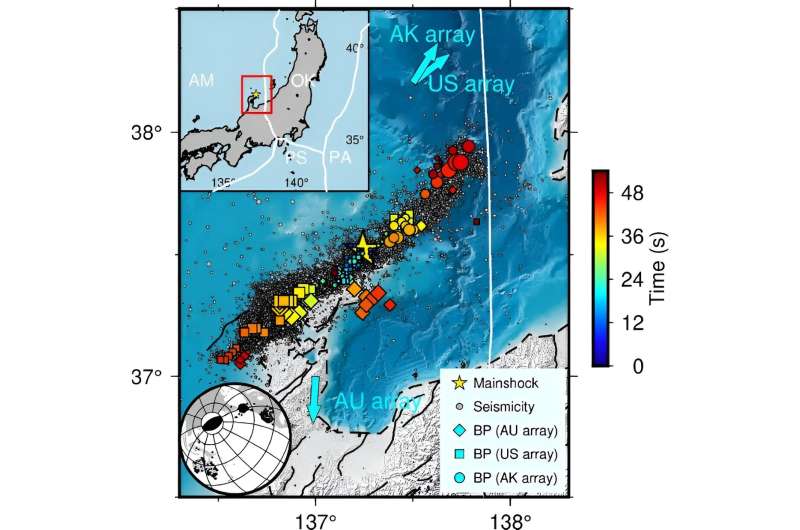This article has been reviewed according to Science X's editorial process and policies. Editors have highlighted the following attributes while ensuring the content's credibility:
fact-checked
peer-reviewed publication
trusted source
proofread
Researchers discover dual epicenters in New Year's Day Noto earthquake

The first seven months of 2024 have been so eventful, it's easy to forget that the year started off with a magnitude 7.5 earthquake centered beneath Japan's Noto Peninsula on New Year's Day. The earthquake killed more than 280 people and damaged more than 83,000 homes.
Geologists have now discovered that the earthquake began almost simultaneously at two different points on the fault, allowing the seismic rupture to encircle and break through a resistant area on the fault known as a barrier. This rare "dual-initiation" mechanism applied intense pressure from both sides of the barrier, leading to the powerful release of energy and substantial ground shaking across the Noto Peninsula.
The Noto earthquake was preceded by intense seismic swarms, which are sequences of many small earthquakes that can sometimes lead to a larger, catastrophic event. By using advanced seismic and geodetic technologies, the research team meticulously analyzed the movements within the Earth during this swarm that led to the earthquake.
The study, published in the journal Science, offers insight into the role of fault barriers, also known as asperities, in earthquake genesis, and will help improve seismic risk assessments and future earthquake forecasting.
Earthquakes happen when fractures in the Earth's crust, known as faults, allow blocks of rocks on either side of the fault to move past each other. This movement is localized, not continuous along the fault line, because the line is not even or smooth, which dissipates energy and eventually stops the movement.
A barrier is a rough area that locks the two sides of a fault in place. Barriers absorb the energy of fault movement, slowing it down or stopping it altogether. But there's only so much energy the barrier can absorb, and under the right conditions, the pent-up energy causes it to break violently, leading to strong shaking. A swarm of small earthquakes might not be enough to break a barrier, but if much stronger subsequent movement occurs on the fault, the barrier's rupture will release all that stored-up energy.
Led by Lingsen Meng, a UCLA associate professor of earth, planetary and space sciences, UCLA graduate student Liuwei Xu and UC Santa Barbara geophysics professor Chen Ji, an international team of researchers from the United States, France, China and Japan analyzed geospatial data and recordings of seismic waves to understand the relationships between the swarm of smaller tremors and the larger earthquake that followed them. They identified a previously unknown barrier in the region of the swarm.
To their surprise, the New Year's Day earthquake began almost simultaneously in two separate locations on the fault. Energy from each location moved toward the barrier, causing a violent rupture and extremely strong shaking.
"The earthquake started in two places and circled together," Meng said. "The first one started waves that traveled fast and triggered a different epicenter. Then both parts propagated outward together and met in middle, where the barrier was, and broke it."
The mechanics resemble bending a pencil on both ends until it snaps in the middle.
The finding was surprising because although dual initiation, as the process is known, has been seen in simulations, it has been much harder to observe in nature. Dual-initiation mechanisms require just the right conditions, which can be set in the lab but are less predictable in the real world.
"We were able to observe it because Japan has very good seismic monitoring stations and we also used GPS and satellite radar data. We grabbed all the data we could find! It's only through all of this data together that we got really good resolution on this fault and could get into these fine details," Meng said.
The vast majority of earthquakes don't have anywhere near this level of data collected, so it's possible that earthquakes with dual-initiation mechanisms are more common than geologists think.
"It could be that through better imaging and resolution, we'll identify more like this in the future," Meng said.
Earthquakes with dual epicenters have a higher risk for stronger shaking because there is stronger movement. Meng's group plans to consider future scenarios to learn about the conditions and probabilities of these earthquakes.
"Our findings emphasize the complex nature of earthquake initiation and the critical conditions that can lead to large-scale seismic events," Meng said. "Understanding these processes is vital for improving our ability to predict and mitigate the impacts of future earthquakes."
More information: Liuwei Xu et al, Dual-initiation ruptures in the 2024 Noto earthquake encircling a fault asperity at a swarm edge, Science (2024). DOI: 10.1126/science.adp0493
Journal information: Science
Provided by University of California, Los Angeles




















